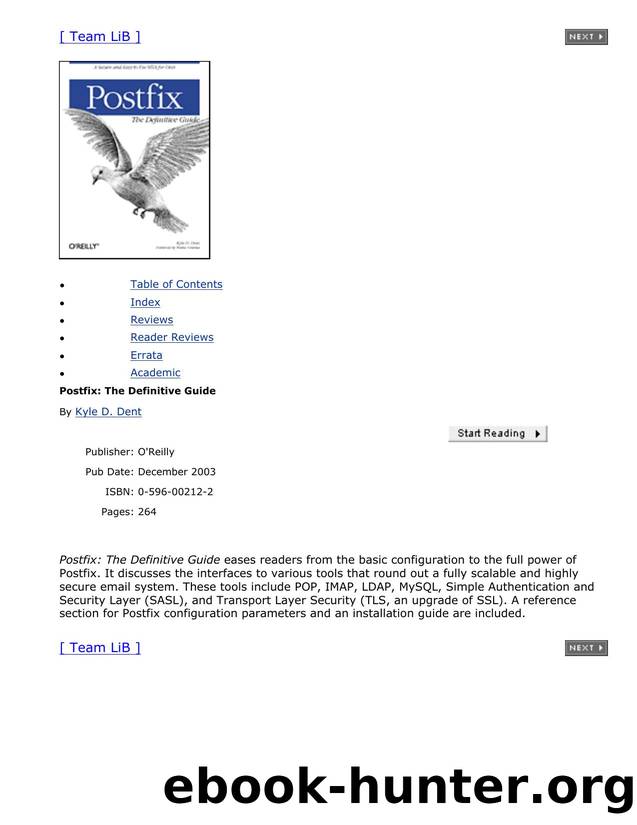Postfix The Definitive Guide by Postfix The Definitive Guide

Author:Postfix The Definitive Guide [Guide, Postfix The Definitive]
Language: fra
Format: epub
Tags: Informatique
Publisher: O'Reilly
Published: 0101-01-01T00:00:00+00:00
addresses in their database that have been identified as spam-friendly open relays. For
example, if the host at IP address 192.168.254.31 has been identified as an open relay, the
(fictitious) DNSBL service No Spam Unlimited using a domain name of nospam.example.com
creates a DNS entry like 31.254.168.192.nospam.example.com. When a client connects to your Postfix system, Postfix can check the No Spam DNS server to see if there is an entry for the
client's IP address. If the IP address has been identified as an open relay system, Postfix can
reject the message.
Consider very carefully before you decide to make use of a DNSBL service. Many open relays
used to forward spam also operate mail services for nonspamming users. You are very likely to
block legitimate mail in addition to the spam. Also keep in mind that you are offloading to a
third party the responsibility of making important decisions about who can and cannot send
mail to your users. On the other hand, if you're buried in spam, DNSBL services can definitely
help. If you decide to use one, review their service options and policies very carefully. Again, you have to balance your aggressiveness and the likelihood of losing legitimate mail against the magnitude of your spam problem.
11.4.2 Content-Based Spam Detection
In addition to identifying clients, you can often recognize spam by its contents. Certain strings within email messages mark them as likely to be spam ("Our Rates Have Never Been Lower!!").
But trying to distinguish spam by the contents of the message can be problematic. Imagine
that you receive lots of spam offering new house mortgages. You figure you can eliminate most
of it by blocking messages that contain words like "really low interest rate on a new mortgage."
This may indeed block many spam messages, but you might also block a message from your
friend (or one of your user's friends) who just got a great deal on a new house and wrote to tell you about it.
11.4.3 Detection Difficulties
The problem with both client- and content-based techniques to identify spam is that spammers
are constantly finding ways to get around them. There is a sort of arms race going on between
legitimate users of email and spammers. You can compile lists of open relays, but spammers
expend a great deal of effort seeking out new open relays or proxy servers to abuse (and there
always seem to be more of them).
You may discover that you receive a lot of spam with the same return address. You can block
messages that use that return address, but spammers use hit-and-run tactics. They obtain an
email address from one of the free email sites and use that address to send thousands or
millions of spam messages, and then discard it for another. Within a couple of days, you'll
never see the address you listed again.
Even content filters have to adjust for spammers escalating tactics. Some spammers embed
HTML codes within the words of their messages to break up phrases you might filter against. Or
they encode the entire message so that when Postfix scans it for recognized spam phrases,
there are no intelligible phrases. Most email clients oblige users by automatically rendering such messages—decoding or ignoring extraneous HTML codes.
Download
This site does not store any files on its server. We only index and link to content provided by other sites. Please contact the content providers to delete copyright contents if any and email us, we'll remove relevant links or contents immediately.
Life 3.0: Being Human in the Age of Artificial Intelligence by Tegmark Max(5474)
The Sports Rules Book by Human Kinetics(4294)
The Age of Surveillance Capitalism by Shoshana Zuboff(4210)
ACT Math For Dummies by Zegarelli Mark(3994)
Unlabel: Selling You Without Selling Out by Marc Ecko(3588)
Blood, Sweat, and Pixels by Jason Schreier(3566)
Hidden Persuasion: 33 psychological influence techniques in advertising by Marc Andrews & Matthijs van Leeuwen & Rick van Baaren(3472)
The Pixar Touch by David A. Price(3364)
Bad Pharma by Ben Goldacre(3356)
Urban Outlaw by Magnus Walker(3340)
Project Animal Farm: An Accidental Journey into the Secret World of Farming and the Truth About Our Food by Sonia Faruqi(3177)
Kitchen confidential by Anthony Bourdain(3009)
Brotopia by Emily Chang(3001)
Slugfest by Reed Tucker(2941)
The Content Trap by Bharat Anand(2860)
The Airbnb Story by Leigh Gallagher(2799)
Coffee for One by KJ Fallon(2566)
Smuggler's Cove: Exotic Cocktails, Rum, and the Cult of Tiki by Martin Cate & Rebecca Cate(2471)
Beer is proof God loves us by Charles W. Bamforth(2371)
